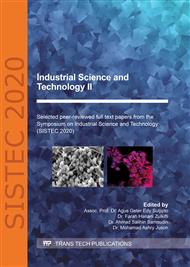[1]
Y. Wang, K.S. Chen, J. Mishler, S.C. Cho, X.C. Adroher, A review of polymer electrolyte membrane fuel cells: Technology, applications, and needs on fundamental research, Appl. Energ. 88 (2011) 981-1007.
DOI: 10.1016/j.apenergy.2010.09.030
Google Scholar
[2]
Y. Nagao, Progress on highly proton-conductive polymer thin films with organized structure and molecularly oriented structure, Sci. Tech. Adv. Mater 21 (2020) 79-91.
DOI: 10.1080/14686996.2020.1722740
Google Scholar
[3]
Y. Nagao, Proton-conductivity enhancement in polymer thin films, Langmuir 33 (2017) 12547-12558.
DOI: 10.1021/acs.langmuir.7b01484
Google Scholar
[4]
T. Abe, M. Kaneko, Reduction catalysis by metal complexes confined in a polymer matrix, Prog. Polym. Sci. 28 (2003) 1441-1488.
DOI: 10.1016/s0079-6700(03)00057-1
Google Scholar
[5]
M. Sono, M.P. Roach, E.D. Coulter, J.H. Dawson, Heme-containing oxygenases, Chem. Rev. 96 (1996) 2841-2888.
DOI: 10.1021/cr9500500
Google Scholar
[6]
J.P. Collman, P. Denisevich, Y. Konai, M. Marrocco, C. Koval, F.C. Anson, Electrode catalysis of the four-electron reduction of oxygen to water by dicobalt face-to-face porphyrins, J. Am. Chem. Soc. 102 (1980) 6027-6036.
DOI: 10.1021/ja00539a009
Google Scholar
[7]
M. Pérez-Morales, G. de Miguel, E. Muñoz, M.T. Martín-Romero, L. Camacho, Oxygen storage/release in cobalt porphyrin electrodeposited films, Electrochim. Acta 54 (2009) 1791-1797.
DOI: 10.1016/j.electacta.2008.09.070
Google Scholar
[8]
B. Su, I. Hatay, A. Trojánek, Z. Samec, T. Khoury, C.P. Gros, J.-M. Barbe, A. Daina, P.-A. Carrupt, H.H. Girault, Molecular electrocatalysis for oxygen reduction by cobalt porphyrins adsorbed at liquid/liquid interfaces, J. Am. Chem. Soc. 132 (2010) 2655-2662.
DOI: 10.1021/ja908488s
Google Scholar
[9]
A. Yella, H.-W. Lee, H.N. Tsao, C. Yi, A.K. Chandiran, M.K. Nazeeruddin, E.W.-G. Diau, C.-Y. Yeh, S.M. Zakeeruddin, M. Graetzel, Porphyrin-sensitized solar cells with cobalt (ii/iii)-based redox electrolyte exceed 12% efficiency, Science 334 (2011) 629-634.
DOI: 10.1126/science.1209688
Google Scholar
[10]
W. Zhang, W. Lai, R. Cao, Energy-related small molecule activation reactions: Oxygen reduction and hydrogen and oxygen evolution reactions catalyzed by porphyrin- and corrole-based systems, Chem. Rev. 117 (2017) 3717-3797.
DOI: 10.1021/acs.chemrev.6b00299
Google Scholar
[11]
D. Li, B.I. Swanson, J.M. Robinson, M.A. Hoffbauer, Porphyrin based self-assembled monolayer thin films: Synthesis and characterization, J. Am. Chem. Soc. 115 (1993) 6975-6980.
DOI: 10.1021/ja00068a068
Google Scholar
[12]
F. Da Cruz, K. Driaf, C. Berthier, J.M. Lameille, F. Armand, Study of a self-assembled porphyrin monomolecular layer obtained by metal complexation, Thin Solid Films 349 (1999) 155-161.
DOI: 10.1016/s0040-6090(99)00169-8
Google Scholar
[13]
Y. Shen, J. Liu, J. Jiang, B. Liu, S. Dong, Fabrication of a metalloporphyrin−polyoxometalate hybrid film by a layer-by-layer method and its catalysis for hydrogen evolution and dioxygen reduction, J. Phys. Chem. B 107 (2003) 9744-9748.
DOI: 10.1021/jp035274y
Google Scholar
[14]
S. Laokroekkiat, M. Hara, S. Nagano, Y. Nagao, Metal-organic coordination network thin film by surface-induced assembly, Langmuir 32 (2016) 6648-6655.
DOI: 10.1021/acs.langmuir.6b01251
Google Scholar
[15]
A. Marcos-Fernández, A.E. Lozano, L. González, A. Rodríguez, Hydrogen bonding in copoly(ether−urea)s and its relationship with the physical properties, Macromolecules 30 (1997) 3584-3592.
DOI: 10.1021/ma9619039
Google Scholar
[16]
P. Kohli, G.J. Blanchard, Applying polymer chemistry to interfaces: Layer-by-layer and spontaneous growth of covalently bound multilayers, Langmuir 16 (2000) 4655-4661.
DOI: 10.1021/la000120k
Google Scholar
[17]
S.M.N. Uddin, Y. Nagao, Multilayer growth of porphyrin-based polyurea thin film using solution-based molecular layer deposition technique, Langmuir 33 (2017) 12777-12784.
DOI: 10.1021/acs.langmuir.7b03450
Google Scholar
[18]
M.A. Rashed, S. Laokroekkiat, M. Hara, S. Nagano, Y. Nagao, Fabrication and characterization of cross-linked organic thin films with nonlinear mass densities, Langmuir 32 (2016) 5917-5924.
DOI: 10.1021/acs.langmuir.6b00540
Google Scholar
[19]
P.W. Loscutoff, H. Zhou, S.B. Clendenning, S.F. Bent, Formation of organic nanoscale laminates and blends by molecular layer deposition, ACS Nano 4 (2010) 331-341.
DOI: 10.1021/nn901013r
Google Scholar
[20]
V. Campo Dall' Orto, R. Carballo, J.A. Hurst, I. Rezzano, Uv–vis spectroscopic study of co(ii)/co(iii) oxidation in poly[m-protoporphyrins] films and their interaction with axial ligands, Spectrochim. Acta A 61 (2005) 2089-2093.
DOI: 10.1016/j.saa.2004.08.010
Google Scholar
[21]
X. Zhou, S.-W. Kang, S. Kumar, R.R. Kulkarni, S.Z.D. Cheng, Q. Li, Self-assembly of porphyrin and fullerene supramolecular complex into highly ordered nanostructure by simple thermal annealing, Chem. Mater. 20 (2008) 3551-3553.
DOI: 10.1021/cm800383q
Google Scholar


